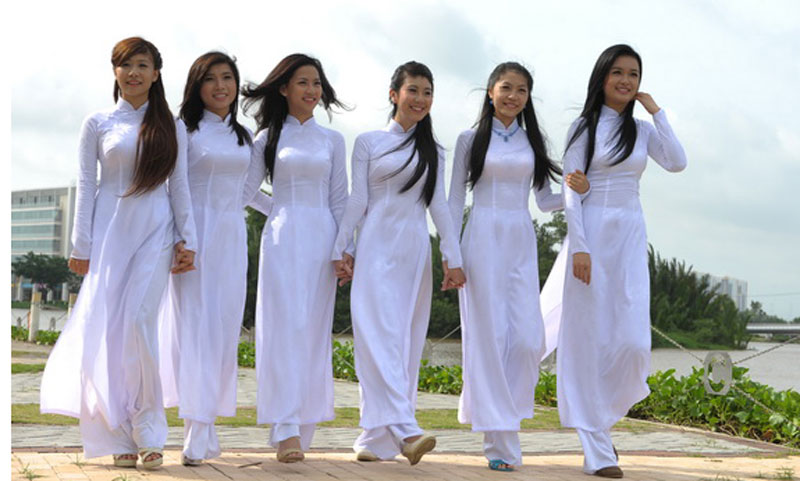The "ao dai" ("flowing tunic") has been the traditional dress for Vietnamese women long, long ago. There are many different kinds of ao dai: the four-part flowing tunic had two equal front flaps that women tied together, while the five-part flowing tunic had an additional small front flap that buttoned up onto the right side of the dress.
Different regions of the country have their own styles of flowing tunic. In the north, Vietnamese women usually wear the four-part flowing tunic, refers to as "Ao Tu Than", with a long skirt. The hat is called "Non Quai Thao".

On the right, instead of wearing "nonquaithao", Nothern women just simply wear a scarf as a variety.
In the Central Region, and in the South of Vietnam, "ao dai" is worn. It is a long flowing tunic that consists of only 2 parts and is worn over a loose-fitting pair of either white, black, or colored pants. However, the white pants are usually preferred over the others. The dress splits into a front and back panel from the waist down. It is also buttoned down on the 1eft side to the waist. There are many stylish variations in color and collar design.

White, or violet ao dai is also worn by Vietnamese students as their uniforms.
The cone-shaped hat is called "non la". Non la in these two pictures is more for posing and decorating. In reality, non la is more functional than decorative. It is used indeed like a hat to protect one from the heat and the sun in everyday life situation. However, in weddings (brides), festivals, or any formal event, a headdress (a diadem - as in the middle picture) is usually preferred. Note: neither nonla, nor the headdress is required to be worn with ao dai.

Anyone who has seen the exquisite costumes worn by Vietnamese women will recognize similarities in the traditional dress of the male. Men costumes are worn with the conventional snug collar and buttoned down on the 1eft side to the waist, with no crease in front or back. The male dress extends only to the knees and is more loose-fitting.

There are many variations on the basic theme. At the top of the list is the elaborate dress of the emperor and the mandarins. Their rank was shown in the display of color in the brocade and embroideries. Gold brocade with embroidered dragons was for the emperor only. Gold is the national color and the dragon heads the fabulous mythical animal world. Purple is the color reserved for high-ranking court mandarins, while blue is for those of lower rank.

Costumes worn for religious ceremonies also have their special colors. Dresses for ceremonial occasions usually have very wide and ample sleeves. Wedding dresses are similar to the popular fashions, and the color is usually purple or blue brocade. Dresses for mourning have frayed fringes or a line up the back and may be either black or white in color.
(based on the writing of Van Ngan)



















